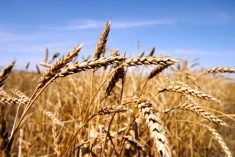Wheat prices are the lowest in actual value since the Civil War, and only farmers are aware of this. Here is some food for thought.
I recently harvested my 64th wheat crop and produced more bushels this year than any other year. Many Kansas farmers have had the same experience. Because of record yields, most people will assume this is also a good financial year for wheat farmers. Unfortunately, the low price will not cover the cost of production for most farms.
During the hard times of the 1890s, the era of the Populist Party, a farmer wrote to his local newspaper to complain about the editor’s misconceptions about farming. He noted that when farmers have a good wheat crop the newspaper declares the farmers must be rich because the wheat made 25 bushels an acre. What the editor failed to point out was that the price had dropped to 25 cents a bushel. Another year when production was down and prices were up, the farmer noted, the editor declared the farmers must be rich because wheat is up to $1 a bushel (all figures in U.S. dollars).
But the editor failed to point out that the farmers had nothing to sell. Many farmers are feeling the same way today.
While the custom harvesters were cutting my 2,000 acres of wheat this year and the price at the local elevator was hovering around $3 a bushel, I checked to see how this compared to previous eras of low commodity prices (see chart below). After looking at prices during the era of the dust bowl and Great Depression, converting those figures to 2016 dollars (result of inflation), I was astonished to discover the value of wheat is lower today. Wheat in 1932 sold for a national average of 38 cents a bushel, but that would equal $6.67 in 2016 dollars.
During the New Deal when federal programs were inaugurated to help farmers survive, the U.S. Department of Agriculture came up with something called “parity” which was based on farm costs and income during the period 1910-14, a time when commodity prices covered the costs of production and a reasonable profit. The USDA computes parity for many products each year, and the parity price for wheat in 2016 is $18.30 per bushel. The latest estimate for national average price of the 2016 crop is $3.45. That is 19 per cent of parity.
The statistics that follow (all available online through USDA and other sources) show national average price for wheat in selected years, followed by inflation adjustment for value of that price in 2016 dollars. It is important to remember these are averages. Some farmers had crop failures and nothing to sell. Some farmers had good production and sold when prices were good and did very well.
Read Also

June’s fast-moving grain markets
Summing up the grain markets: June 2025 was an interesting month for canola prices and geopolitics stole the spotlight from grain market specifics
Even so, the averages indicate the state of the farm economy.
Any time commodity prices fall below the cost of production, every consumer is being subsidized by farmers. It should be noted that federal farm subsidies were designed to provide cheap food; the major item in every Farm Bill is food stamps. The amount going to farmers is partial compensation for providing food for consumers at less than the cost of production.
At current prices, the farmer’s share received for the flour in a loaf of bread is five cents. If farmers received parity price today, the farmer’s share in that loaf of bread would be 26 cents. This means the farmer is contributing 21 cents to your loaf of bread. If you think this is fair, please do not complain about farmers with your mouth full.
Congress could fix this problem with a new Farm Bill, but today Congress is deadlocked and unable to do much of anything. Kansas does not have a representative on the House Agricultural Committee. Historically, the national economy has prospered when farmers have prospered. Although less than two per cent of the U.S. population is engaged in agriculture, how they fare economically affects everyone.
Before we can solve a problem, we need to understand it. I hope this summary of wheat prices helps you understand the problem. Remember, as President John F. Kennedy said, farmers are the only people who have no control over the price of inputs or the market value of their product.
The national average cost to produce an acre of wheat in 2016 is $315.78. The projected national average yield for 2016 is 50.5 bushels an acre. At $3.45 average price a bushel, national average income per acre is projected at $174.23 (that is 55 per cent of the cost of production).
We deserve better.
Leo Oliva is a historian and author who lives in Woodston, Kan.




















